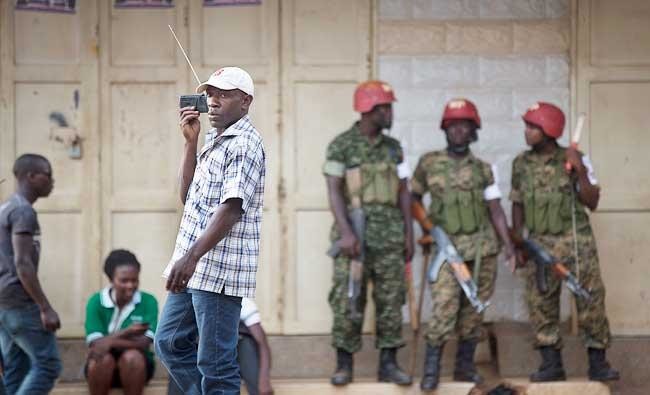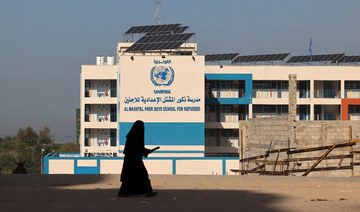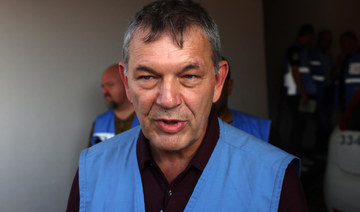KAMPALA: The mysterious Facebook blogger kept dishing up alleged government secrets. One day it was a shadowy faction looting cash from Uganda’s presidential palace with impunity. The next was a claim that the president was suffering from a debilitating illness.
For authorities in a country that has seen just one president since 1986, the critic who goes by Tom Voltaire Okwalinga is an example of the threat some African governments see in the exploding reach of the Internet — bringing growing attempts to throttle it.
Since 2015 about a dozen African countries have had wide-ranging Internet shutdowns, often during elections. Rights defenders say the blackouts are conducive to carrying out serious abuses.
The Internet outages also can inflict serious damage on the economies of African countries that desperately seek growth, according to research by the Brookings Institution think tank.
Uganda learned that lesson. In February 2016, amid a tight election, authorities shut down access to Facebook and Twitter as anger swelled over delayed delivery of ballots in opposition strongholds. During the blackout, the police arrested the president’s main challenger. Over $2 million was shed from the country’s GDP in just five days of Internet restrictions, the Brookings Institution said.
The shutdowns also have “potential devastating consequences” for education and health, says the Mo Ibrahim Foundation, an organization founded by a mobile phone magnate that monitors trends in African governance.
As more countries gain the technology to impose restrictions, rights observers see an urgent threat to democracy.
“The worrying trend of disrupting access to social media around polling time puts the possibility of a free and fair electoral process into serious jeopardy,” said Maria Burnett, associate director for the Africa division of Human Rights Watch.
In the past year, Internet shutdowns during elections have been reported in Gabon, Republic of Congo and Gambia, where a long-time dictator cut off the Internet on the eve of a vote he ultimately lost.
In Uganda, where the opposition finds it hard to organize because of a law barring public meetings without the police chief’s authorization, the mysterious blogger Okwalinga is widely seen as satisfying a hunger for information that the state would like to keep secret. His allegations, however, often are not backed up with evidence.
It is widely believed that Uganda’s government has spent millions trying to unmask Okwalinga. In January an Irish court rejected the efforts of a Ugandan lawyer who wanted Facebook to reveal the blogger’s identity over defamation charges.
“What Tom Voltaire Okwalinga publishes is believable because the government has created a fertile ground to not be trusted,” said Robert Shaka, a Ugandan information technology specialist. “In fact, if we had an open society where transparency is a key pillar of our democracy there would be no reason for people like Tom Voltaire Okwalinga.”
In 2015, Shaka himself was arrested on suspicion of being the blogger and charged with violating the privacy of President Yoweri Museveni, allegations he denied. While Shaka was in custody, the mystery blogger kept publishing.
“Who is the editor of Facebook? Who is the editor of all these things they post on social media? Sometimes you have no option, if something is at stake, to interfere with access,” said Col. Shaban Bantariza, a spokesman for the Ugandan government.
Although the government does not like to impose restrictions, the Internet can be shut down if the objective is to preserve national security, Bantariza said.
In some English-speaking territories of Cameroon where the locals have accused the central government of marginalyzing their language in favor of French, the government has shut down the Internet for several weeks.
Internet advocacy group Access Now earlier estimated that the restrictions in Cameroon have cost local businesses more than $1.39 million.
“Internet shutdowns — with governments ordering the suspension or throttling of entire networks, often during elections or public protests — must never be allowed to become the new normal,” Access Now said in an open letter to Internet companies in Cameroon, saying the shutdowns cut off access to vital information, e-financing and emergency services.
In Zimbabwe, social media is a relatively new concern for the government following online protests launched by a pastor last year. Aside from blocking social media at times, the government has increased Internet fees by nearly 300 percent.
In Ethiopia, where a government-controlled company has a monopoly over all telecom services, Internet restrictions have been deeply felt for months. The country remains under a state of emergency imposed in October after sometimes deadly anti-government protests. Restrictions have ranged from shutting down the Internet completely to blocking access to social media sites.
Just 30 days of Internet restrictions between July 2015 and July 2016 cost Ethiopia’s economy over $8 million, according to figures by the Brookings Institution. The country has been one of Africa’s fastest-growing economies.
Ethiopia’s government insists social media is being used to incite violence, but many citizens are suspicious of that stance.
“What we are experiencing here in Ethiopia is a situation in which the flow of information on social media dismantled the traditional propaganda machine of the government and people begin creating their own media platforms. This is what the government dislikes,” said Seyoum Teshome, a lecturer at Ethiopia’s Ambo University who was jailed for 82 days last year on charges of inciting violence related to his Facebook posts.
“The government doesn’t want the spread of information that’s out of its control, and this bears all the hallmarks of dictatorship,” Seyoum said.
African govts learn to block the Internet, but at a cost
African govts learn to block the Internet, but at a cost

Three Spanish, three Afghans killed in shooting in Afghanistan

- The group were fired on while walking through a market in the mountainous city of Bamiyan
- Among eight others wounded, four were foreigners from Norway, Australia, Lithuania and Spain
KABUL: The bodies of three Spanish tourists and three Afghans shot dead while on a tour in Afghanistan were transported to the capital along with multiple wounded, the Taliban government said Saturday.
The group were fired on while walking through a market in the mountainous city of Bamiyan in central Afghanistan, around 180 kilometers (100 miles) from the capital Kabul, on Friday evening.
“All dead bodies have been shifted to Kabul and are in the forensic department and the wounded are also in Kabul. Both dead and wounded include women,” the government’s interior ministry spokesman Abdul Mateen Qani told AFP.
“Among the eight wounded, of whom four are foreigners, only one elderly foreign woman is not in a very stable situation.”
Qani said the death toll had risen to six, including two Afghan civilians and one Taliban member.
Spain’s foreign ministry on Friday announced that three of the dead were Spanish tourists, adding that at least one other Spanish national was wounded.
According to preliminary information provided by hospital sources, the wounded were from Norway, Australia, Lithuania and Spain.
“They were roaming in the bazaar when they were attacked,” Qani added.
“Seven suspects have been arrested of which one is wounded, the investigation is still going on and the Islamic Emirate is seriously looking into the matter.”
He did not say if there had been multiple shooters.
Spanish Prime Minister Pedro Sanchez posted on X, formerly Twitter: “Overwhelmed by the news of the murder of Spanish tourists in Afghanistan.”
The European Union condemned the attack “in the strongest terms.”
“Our thoughts are with the families and loved ones of the victims who lost their lives and those injured in the attack,” the bloc said in a statement.
The Taliban government, which took power in 2021 after a decade-long insurgency against foreign forces, has yet to be officially recognized by any government.
It has, however, supported a fledgling tourism sector, with more than 5,000 foreign tourists visiting Afghanistan in 2023, according to official figures.
Tourists holiday without consular support, after most embassies were evacuated, and many Western nations advise against all travel to the country, warning of kidnap and attack risks.
Alongside security concerns, the country has limited road infrastructure and a dilapidated health service.
Bamiyan is Afghanistan’s top tourist destination, known for turquoise lakes and striking mountains, and once home to the giant Buddha statues that were blown up by the Taliban in 2001 during their previous rule.
The number of bombings and suicide attacks in Afghanistan has reduced dramatically since the Taliban authorities took power and deadly attacks on foreigners are rare.
However, a number of armed groups, including the Daesh group, remain a threat.
The jihadist group has waged a campaign of attacks on foreign interests in a bid to weaken the Taliban government, targeting Pakistan and Russian embassies as well as Chinese businessmen.
Austria to resume aid to UN agency for Palestinians

- Many countries, including Germany, Sweden, Canada and Japan, had resumed funding
- A total of 3.4 million euros ($3.7 million) in funds have been budgeted for 2024
VIENNA: Austria said Saturday it will restore its funding to the UN agency for Palestinian refugees after suspending it over allegations that staff were involved in the October 7 Hamas attacks.
Israel alleged in January that some United Nations Relief and Works Agency (UNRWA) employees may have participated in the Hamas attacks on October 7 that triggered the war in the Gaza Strip.
In the weeks that followed, numerous donor states, including Austria, suspended or paused some $450 million in funding.
Many, including Germany, Sweden, Canada and Japan, had since resumed funding, while others have continued to hold out.
“After analizing the action plan in detail” submitted by UNRWA “to improve the functioning of the organization,” Austria has decided to “release the funds,” its foreign ministry said in a statement.
A total of 3.4 million euros ($3.7 million) in funds have been budgeted for 2024, and the first payment is expected to be made in the summer, the statement said.
“Some of the Austrian funds will be used in the future to improve internal control mechanisms at UNRWA,” it added.
Austria said it will “closely monitor” the implementation of the action plan with other international partners, noting that “a lot of trust had been squandered.”
The Alpine country said it has substantially increased support for the suffering Palestinian population in Gaza and the region since 7 October, making 32 million euros ($34.8 million) in humanitarian aid available to other international aid organizations.
The Hamas attack on October 7 resulted in the death of more than 1,170 people in Israel, most of them civilians, according to an AFP tally based on official Israeli figures.
Israel’s campaign in Gaza has since killed at least 35,303 people, also mostly civilians, according to data provided by the health ministry in the Hamas-run territory.
Flash floods kill at least 50 people in western Afghanistan

- Death toll was based on preliminary reports and might rise
- Hard-hit province of Ghor has suffered significant financial losses
ISLAMABAD: Flash floods from heavy seasonal rains in western Afghanistan have killed at least 50 people and dozens remain missing, a Taliban official said on Saturday, adding the death toll was based on preliminary reports and might rise.
Afghanistan has been witnessing unusually heavy seasonal rains.
The hard-hit province of Ghor has suffered significant financial losses, said Abdul Wahid Hamas, spokesman for the provincial governor, after thousands of homes and properties were damaged and hundreds of hectares of agricultural land destroyed following Friday’s floods, including the capital city Feroz Koh.
The Taliban’s government chief spokesman posted on social platform X, mourning “the loss of our fellow Afghans,” and urged ” responsible authorities ... to provide all necessary support to alleviate the suffering.” He also called on “our benevolent donors” to help and humanitarian organizations to provide the affected communities with aid.
Last week, the UN food agency said the exceptionally heavy rains in Afghanistan have killed more than 300 people and destroyed thousands of houses, mostly in the northern province of Baghlan, which bore the brunt of floods on May 10th.
Survivors have been left with no home, no land, and no source of livelihood, the World Food Organization said. Most of Baghlan is “inaccessible by trucks,” said WFP, adding that it is resorting to every alternative it can think of to deliver food to the survivors.
The latest disaster came on the heels of devastating floods that killed at least 70 people in April. The waters also destroyed about 2,000 homes, three mosques and four schools in western Farah and Herat, and southern Zabul and Kandahar provinces.
Nearly 10,000 evacuated in Ukraine’s Kharkiv region: governor

- Ukrainian President Volodymyr Zelensky plays down Russia’s gains in the offensive
- Moscow has been attacking several settlements including Vovchansk, just five kilometers from the border
KYIV: Nearly 10,000 people have been forced to leave their homes in Ukraine’s northeastern Kharkiv region since a ground attack launched by Russian forces on May 10, the regional governor said.
The assault may only be the first wave of a wider offensive, Ukrainian President Volodymyr Zelensky said.
Over a week after its launch, “a total of 9,907 people have been evacuated,” governor Oleg Synegubov said.
They were fleeing Russian soldiers who managed to advance between five to 10 kilometers (three to six miles) along the northeastern border before being stopped by Ukrainian forces.
Synegubov said Ukraine’s armed forces had repelled two attempts to break through defenses overnight.
The situation was “under control” with “defenders in certain areas conducting assault... and combing operations.”
Moscow has been attacking several settlements including Vovchansk, just five kilometers from the border.
“In the area of the city of Vovchansk, Ukrainian troops are reinforcing their defense,” Synegubov said.
A day earlier, he said Russian forces have started to destroy Vovchansk and all but 200 of its residents have fled due to fighting.
Russian forces have taken 278 square kilometers (107 square miles) between May 9 and 15, their biggest gains since the end of 2022, AFP calculated using data from the Institute for the Study of War (ISW).
Russia’s offensive “could consist in several waves. There was the first wave” in the Kharkiv region, Zelensky said journalists.
Zelensky played down Russia’s gains in the offensive but added: “We have to be sober and understand that they are going deeper into our territory. Not vice versa. And that’s still their advantage.”
Speaking about the offensive during a visit to China on Friday, Russian President Vladimir Putin said it was a response to Ukraine shelling border regions.
Nepal latest to ban Indian spice brands over safety concerns

- Hong Kong, Singapore last month banned products from Everest and MDH after tests detected presence of ethylene oxide
- Besides its use as a pesticide, ethylene oxide is used to sterilize medical equipment and as a sterilising agent in spices
KATMANDU: Nepal has become the latest jurisdiction to ban the import and sale of two popular Indian spice brands after reports that some of their products contained a cancer-causing pesticide, officials said Friday.
Hong Kong and Singapore last month banned products from Everest and MDH — two brands popular in India and exported worldwide — after tests detected the presence of ethylene oxide, according to media reports.
Besides its use as a pesticide, ethylene oxide is used to sterilize medical equipment and as a sterilising agent in spices to prevent illnesses caused by salmonella and E. Coli bacteria.
Regular exposure to the colorless and odourless compound increases the “risk of cancers of the white blood cells,” according to the US Environmental Protection Agency.
Matina Joshi Vaidya, chief of Nepal’s Department of Food Technology and Quality Control, told AFP that the Himalayan country had also decided to halt the sale of the spice blends.
“It is an issue of public health,” she said. “We have its banned import and sale from Thursday.”
Nepal has banned four products — three variants produced by MDH and one by Everest.
“We do not have the lab resources to run the tests in the country. The ban will be lifted when Indian authorities declare it safe,” Vaidya said.
Everest and MDH are India’s top two spice brands with a market share of 16 and 10 percent respectively in 2022, according to consumer research monitor Statista.
Both companies have put out statements denying their products pose a health hazard to consumers after the Singapore and Hong Kong import bans.
“We clarify and state unequivocally that these claims are untrue and lack any substantiating evidence,” MDH said last month on social media platform X.
India’s food regulation agency has asked for state authorities to carry out random testing of spice products, broadcaster NDTV reported.
















